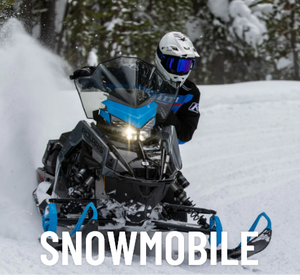Simply select "affirm" at checkout.

How to change the oil on a motorcycle
So the week is going faster than I had hoped but to keep up with my info on all things motorcycle I thought I would do a write up on changing your oil on a motorcycle instead of doing a video this week.
Changing your oil is one of the most important things to do to keep your bike is good working condition. The oil in the engine and transmission is the only thing that is preventing metal on metal contact with the parts in your engine and trans. The oil provides a layer between those parts. The cleaner the oil the better the protection.
Note: grab your owners manual. Most are available online now for free.
-1, First thing, you need new oil, filter and crush washer. I won't go into the debate on whether to use synthetic or mineral oil or what brand to use. The most important thing is to make sure you use a quality brand that is MADE FOR MOTORCYCLES. Car oil is not made to handle the motorcycle's wet clutch. My personal opinion is I like and use synthetic oil, it is not much more and I feel that it just does a better job and it is the newest technology. I don't think any of us listen to 8 tracks or tapes anymore because they are "good enough or cheaper"
-2, Start with either taking your bike for a ride or let it run long enough to get the engine and its oil up to operating temperature. This way it will mix up all the gunk that might have settled at the bottom of the case and it will pour out easier. Warming it up will leave you with a "cleaner" case and most of the oil and or the gunk will come out when you drain it.
-3, Find the drain bolt and oil filter, (owner's manual is your friend) On some bikes this is very easy ie no fairings, but on some this can be a little tough and you might have to remove some fairings. Most bikes will have a 17mm bolt under the engine/trans, usually in the middle somewhere. The oil filter usually will be up front on the vertical pointing toward the front wheel. It will look like a large black coffee cup without the handle. Now to get the filter off. Hopefully the last person to change the oil didn't go ape and tighten the filter to the point that it won't come off easily. There are filter wrenches and sockets and all kinds of tools to help with this, they are inexpensive and if you plan to do your own oil changes it is a good idea to pick one up for yourself. Shameless plug, we sell K&N filters and stock all their part numbers, they have a 17mm nut molded into the end of their filters so all you need to get it off is the same 17mm socket you used to remove the drain bolt, (smart & very easy!). Also for all you racers or track day guys there is a small hole in nut on the filter that you can safety wire the filter. (also easy and smart). Remove the drain bolt (righty tighty, lefty loosy) and you will be upside down so make sure you are pushing or pulling in the correct direction, some case can be softer metal and you don't want to strip the threads. Drain your oil and take your filter off. We can take your old oil and old oil filter for free at the shop so you don't have to burn it in the campfire out back. (you know you do). Note on Harley Davidson's: Harley uses two cases, one for the engine and one for the transmission, so you have to drain the oil from separate cases and there will be two drain bolts and two fill caps. Harley also uses primary drive oil in another case. We call this the three whole oil change. Most oil manufactures state that you can use the same oil for all three, some manufactures have different bottles/oil mixes for the three.
-4 Install your new oil filter and put the drain plug back in. Fill your new filter with oil so when your start the bike there is no chance of the engine starving for oil because of waiting for the filter to fill before it can pump oil. Before you install the new filter, make sure that the rubber o-ring seal from the old filter came off the engine when you removed it and is not still stuck to the engine case. Install your new crush washer on your drain plug. We include this for free when you buy your oil and filter from us. I have used crush washers more than once without problem but the idea is that they mushroom/crush out a little bit when you tighten the drain bolt to make a really good seal to the case. So it is recommended not to reuse them. Now when you install the drain bolt it is best to use the manufacture torque specs. If you don't have a torque wrench and want to do you own work you should get one. You can get away without it but go easy because like I said above some engine cases can be soft metal and it is easy to strip this.
-5 So now that everything is closed up, you are ready to add your new oil. Bikes can take different amounts of oil and they have different ways to check the oil. Some have dip sticks, and some dip sticks you have to screw in to get the right reading some you do not, a lot of bikes have windows that show the oil level. Some bikes you can check the oil level on the kick stand, some you have to put them strait/upright. Again your manual is your friend. You can find the correct amount of oil for your engine in your manual. The manual usually list two amounts. One if you did change the filter ie more, and one if you didn't change the filter ie less. Sometimes you can get away with not changing the filter between oil changes, but I feel why bother because the filter is around $20 to protect a $5000 motor. When I was racing I used to only change the filter every second oil change but I was changing the oil every race round weekend. (Probably a little excessive but made me feel good. haha). Pour in your oil up to the correct reading either on the dip stick or the window. Close up the fill pug and start the bike, this will ensure the oil fills the rest of the filter from some of the oil that drained out when you put it on. It will pump the oil all though the engine and trans. You only need to let it run a couple of minutes. Then let is set for 5-10 minutes for the oil to settle back down in the case and check it again, it is normal to have to add a little bit more oil to top it up. You should have a look at the oil filter and drain bolt just to be sure nothing is leaking. Make sure your filler cap is tight.
-6 Wipe as much oil up, that ran out over everything including the head pipes. Be careful to make sure you didn't get any oil on the tires. Head out for a ride, it will be normal to get a little bit of smoke from the oil being burnt off where you dripped it on the head pipes and cases. On your first stop, take a minute and have a look at the filter and drain bolt again just to make sure everything is good and not leaking. Have a look at the oil level again as well, top up at home if you need to.
-7 Go ride and have fun until the next oil change.
I hope this helps some people that would like to do their own oil changes. It is not hard and nothing to be intimidated about. Just a little prep and education goes a long way. Or if your like me and don't like making a mess in your garage or getting covered in oil, drop it off at the shop and we can do it for you. You keep you hands clean.
Any question or anything I left out let me know in the comments
Cheers
Scott Redden
















Leave a comment